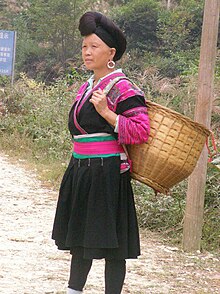Yao



The Yao ( Chinese 瑶族 , Pinyin Yáozú ) are one of the 56 nationalities recognized by the People's Republic of China .
The Yao number in China is 2,796,003 people (2010 census). They live in the mountainous regions in the south and southwest of China. They also settle in northern Laos and Vietnam as well as in Myanmar . Around 60,000 Yao live in northern Thailand . They are counted among the hill tribes there.
The Yao in Thailand call themselves Mien or Iu-Mien , which means something like person, individual or being.
In Vietnam , the Yao is known as Dao, Dzao, Zao or Red Dzao (Red Dzao; actually a subgroup).
The Bunu call themselves Nuox [no13], Buod nuox [po43 no13], Dungb nuox [tuŋ33 no13] or after the official name Yaof zu [ʑau21 su21].
classification
The Yao in China are divided into several groups and speak at least three different languages: Mien ( Chinese 勉 语 , Pinyin Miǎnyǔ ), Bunu ( 布努 语 , Bùnǔyǔ ) and Lakkia ( 拉珈 语 , Lājiāyǔ ). Another large group officially counted as part of the Yao is Zhuang . A group in the island province of Hainan is officially counted among the Miao at its own express request , but speaks Mien. This group, which was settled on Hainan during the Qing Dynasty, then consisted of soldiers and their families. The soldiers were used by the Qing government to suppress the Li , who often rebelled . Although the PRC government made several offers to classify the group as Yao, it was turned down because they identified more strongly with the name "Miao" given to them during the Qing period.
languages
Mien and Bunu belong to the Miao-Yao languages (or Hmong-Mien languages), which Chinese scholars count as Sino-Tibetan languages (most Western scholars disagree with this classification); Lakkia is one of the Tai Kadai languages .
It was not until 1982 that linguists from the Central National Institute in Beijing adopted the five “principles to be observed when creating or reforming the writings of national minorities” ( 创立 或 改革 少数民族 文字 必须 的 遵循 原则 ), which the State Council enacted in December 1957 had created a draft of a Mien written language. In the following years this draft was discussed with linguists and Yao from different countries.
Bunu has been written in Latin script since the 1950s. The standard language distinguishes 65 syllable sounds, 26 end sounds and eight tones.
religion
Their original, written down religion is based on medieval Chinese Taoism . Today, numerous Yao have converted to Buddhism and Christianity .
The first historical mention of the Yao goes back to the 5th century BC. BC back.
- See also: Peoples of Vietnam
literature
- Meng Chaoji蒙朝吉: Hàn-Yao cídiǎn - Bùnǔyǔ汉瑶词典-布努语( Chinese Miao dictionary - Bunu ; Chengdu成都, Szechuan Minzu chūbǎnshè四川民族出版社1996), ISBN 7-5409-1745-8 .
- Hjorleifur Jonsson: Mien Relations. Mountain People And State Control in Thailand. Cornell University Press, Ithaca NY 2005.
Web links
- The Yao ethnic minority (English) - Chinese government site
- The Virtual Hilltribe Museum (English)
